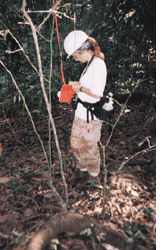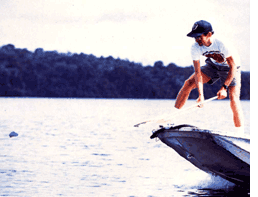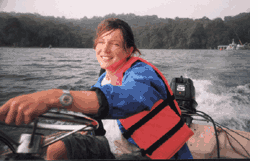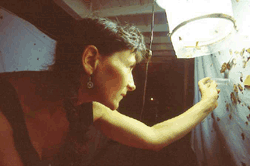 Greg Adler
Greg Adler
A man with a mullet and a mission
"Greg Adler turned out to be a slightly gonzo-looking man with Seventies hair and a Pancho Villa mustache. When we first met, months into my stay, he was wearing a loose, floral-patterned shirt, shorts, and Teva sandals, one of which was held together by a segment of cloth.
"An ecology professor at the University of Wisconsin, Oshkosh, Adler had been censusing and manipulating the populations of spiny rats on twelve small islands in Gatun Lake since 1991. The big question for him had always been: What limits the population density of tropical animals? His island replicates were a perfect setup for playing all manner of intellectually satisfying games, which, if successful, would help him reach an answer.
"Growing up in West Virginia, Adler spent a fair amount of time setting traps for rats and mice. 'I always liked them,' he told me. 'They're model organisms. They're good when you're looking for patterns, and you can extrapolate to other rodents and mammals, within limits.'"
Photograph © Dr. B.L.Travi
-----
 Chrissy Campbell
Chrissy Campbell
Like Al Capone, she never sat with her back to the door.
"Theoretically, it was easy to meet people at mealtimes, when they were relaxed and available for conversation. I'd been watching a redhead named Christina Campbell for two days. She sat at the middle of the long dining table, always facing the trolleys of food. Most people preferred the view of the lake, but Chrissy wanted to see who came in when and with whom. She was surrounded by a gaggle of field assistants, monkey researchers from Berkeley. I wanted to hear about the island's spider monkeys, her study subject, but I didn't get far.
"'Where are you from?' I asked.
"'New Zealand,' she said, and turned pointedly away. I was more amused
by her rudeness than hurt, since I'd done nothing so far to provoke it."
Photograph © E. Royte
-----
 Egbert Leigh
Egbert Leigh
BCI's eminence grise - and the first scientist to offer Elizabeth a drink
"Egbert Leigh arrived at meals promptly, sat facing the great outdoors, and inquired rather formally after the progress of some, but not all, of the researchers. A thin man with a belly and a white beard, he was the island's elder statesman and most esteemed scholar. He published slowly but steadily on the major transitions of evolution, on the evolution of mutualisms, and on the role of selection in evolutionary theory.
"Much to my delight, Bert invited me up for drinks my first night on the island. 'Come in!' he shouted when I knocked on his door. Baroque music boomed from a portable CD player. Bert didn't smile; he barely looked at me. 'Sit where you'd like.' His voice was a little whiny, but that was part of his cultivated eccentricity--a seeming impatience for ordinary social routine. 'What would you like? I've got whiskey, rum, and perhaps a bottle of sherry.' The offer was made almost grudgingly, but again, that was part of Bert's style."
Photograph © Robert Dudley
-----
 Robert Dudley
Robert Dudley
He was a leading authority on insect biomechanics. He also spent a fair amount of time on BCI thinking up ways to murder people.
"Every year, Robert Dudley, an entomology professor from the University of Texas at Austin, made a pilgrimage to Panama to census migrating Lepidoptera, to study frog vocalizations, and to get his annual tropical fix.
"Robert was something of a polymath. He spoke four languages, traveled incessantly, and read widely outside his field, which was unusual in a scientist. He wrote papers on the evolutionary origins of human alcoholism, Antarctic mollusks, and rattlesnake strikes, and he was a leading authority on insect biomechanics. He also spent a fair amount of time thinking up ways to murder people on BCI.
"'Think of all the ways you could get rid of the body,' he said, strangely insistent. There was the lake. There were the carnivorous animals in the forest, the insects and fungi that made recently living organisms disappear virtually overnight. Phones lines could be cut, boat engines disabled. Residents often disappeared for days on end--into the forest, on holiday to the Caribbean coast--so the post-mortem interval would be roomy. Camouflage and crypsis, two mainstays of survival in the forest, contributed to the psychological ambience. So many things were not what they appeared."
Photograph © Courtesy of STRI
-----
 Hubi Herz
Hubi Herz
He moved with the grace of a walking stick.
"From the start, I had noticed Hubi Herz around the dining hall and the lab. He had green eyes that glimmered. He was sharp-jawed and lean. He wore his blond hair in a brush cut, into which his girlfriend had shaved three skinny lines; they looked a lot like leaf-cutter trails. Hubi moved with the grace of a walking stick--the long-legged arthropod, family Phasmatodea, that resembled a twig--and was always popping into the lounge to speak to a friend, then hurrying back out to his own lab, where he studied the effects of leaf-cutter ants on trees. He walked with purpose, as if he had several appointments and his day was already backed up."
Photograph © E. Royte
-----
 Sabine Stuntz
Sabine Stuntz
Visiting her field sites was always something of an adventure. Always, there was boat trouble.
"At 26, Sabine was vivacious, dark-haired, and curvy, with a smattering of freckles across her snub nose. A grad student, she was building traps, more than a hundred of them, to catch and study the arthropods that live in the epiphytes of one tree species. Back in Germany, Sabine had climbed mountains, snowboarded, and skated. In Panama, she wore short skirts, danced salsa, and attracted men the way flight-interceptor traps attracted Polistes wasps."
Photograph © E. Royte
-----
 Jayne Yack
Jayne Yack
The pigtailed lepidopterist
"I was loafing around my lab one night, playing with a tick I'd removed from my arm, when the back door hissed open. It was Jayne Yack, the pigtailed woman I'd seen up by the old dining hall for a couple of nights in a row. Jayne seemed to be all business--not part of any clique and never appearing for meals. That was often the story with people who worked on nocturnal organisms. Jayne was a post-doc from Cornell studying the evolution of hearing in Lepidoptera. When I first saw her, Jayne had been shining a blacklight onto a bedsheet hanging from the balcony. The UV rays attracted dozens of strange, cryptically colored moths. Some of them looked like decaying leaves, others looked like bird scat, lace, or sticks. The insects in turn attracted nocturnal insectivores: bats, frogs, and the insect-eating Bufo marinus, a giant toad. The insectivores attracted their own class of researchers--mostly residents who'd knocked off for the day but couldn't resist messing around with the accidental menagerie."
Photograph © Christian Ziegler
-----
 Bret Weinstein
Bret Weinstein
The accidental hero of our story
"Bret Weinstein was of medium build, with longish wavy hair that he kept out of his eyes with a bandanna. He rarely made it to breakfast or lunch, and he came to dinner late, after most people had finished eating. He worked at night, trying to figure out why certain fruit-eating bats constructed tents from leaves.
"Bret had a reputation for being smart and disorganized. People were always asking him questions--about animals, the field station, people. He'd give ridiculous answers that sounded plausible, gauge his interrogator's reaction, then straighten up. I liked him right away, but it would take weeks for us to feel comfortable enough to work together in the forest, radiotracking bats."
Photograph © Heather Heying
Back to top